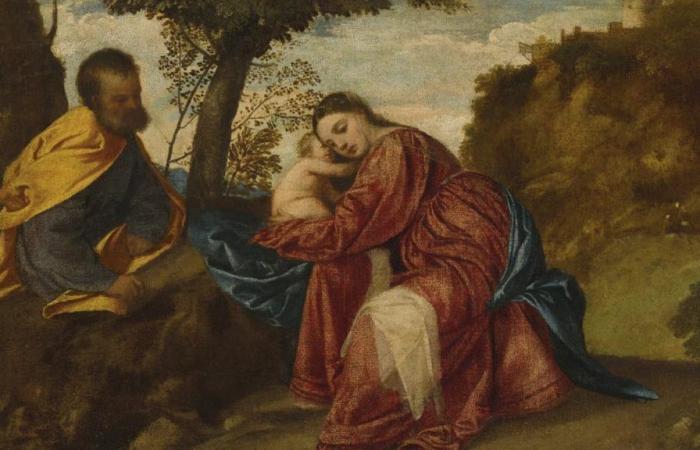There are works of art that are destined to live far from tranquility, and yet are known, in addition to their mastery, for living curious adventures. Da Vinci’s Mona Lisa has experienced numerous attacks or robberies, while the Venus in the mirror This is Velázquez’s most scandalous painting, as it has been torn with a knife or with hammer blows. The case is interesting, for its part, from “Rest on the Flight from Egypt”, work by Titianwhich will be auctioned in July. In this type of sales, the value usually increases if the object in question, in addition to the intrinsic quality in its creation and technique, carries with it a peculiar history or context. And this is the case of this painting: it is a highly coveted painting by the renaissance master, because in addition to being symbolic and majestic, it has been stolen twice and subsequently found at a London bus stop.
Experts point out that Titian created “Rest on the Flight into Egypt” in 1508, when he was barely 20 years old. He painted it on a wooden panel just over half a meter wide, and on it he depicted the figure of the Virgin Mary cradling the Baby Jesus with Saint Joseph looking on. The first time this work was documented dates back to the 17th century, from the collection of Barolomeo de la Nave, a Venetian spice merchant, passing through the following centuries through the hands of aristocrats, emperors and archdukes from all over Europe. In 1878, it was purchased by the 4th Marquess of Bath at an auction Christie’sthe same house that will now sell it again in London, on July 2, on behalf of the last Marquis, and hoping that the sale will reach between 15 and 25 million pounds sterling (between 18 and 30 million euros).
Between dukes and emperors
Orlando Rock, president of Christie’s in the United Kingdom, explains that this early work by Titian “has passed through the hands of dukes, archdukes and emperors of the Holy Roman Empire.” He adds that “this magical devotional painting has the rare notoriety of having been stolen not once, but twice: first by Napoleon and second in the late 1990s.” Indeed, it was in 1809 when Napoleon’s troops sacked the Belvedere Castle in Vienna, taking among others the work of Titian. To the fall of Bonaparte, The work returned to the Austrian capital in 1815, passing into the hands of the Scotsman Hugh Andrew Johnstone Munro, one of the most important patrons of the painter JMW Turner.
When the Titian was auctioned in 1878, it was taken by the aforementioned 4th Marquess of Bath, who hung it in the Wilshire mansion, and there it was stolen again, in 1995. Seven years later, without a frame and in a colorful bag , the curious discovery occurred: the painting appeared at a bus stop, found by Charles Hill, a former Scotland Yard police officer and converted into a detective specialized in tracking down works of art. With this success, He pocketed around 118,000 euros in reward, an amount that is barely close to what it is now estimated that the painting could fetch in the new auction.
This Titian is, in short, and in the words of Andrew Fletcher, director of the Old Masters Department at Christie’s, “the most important work by the artist to reach the auction market in more than a generation. It embodies the pictorial revolution carried out by Titian to beginning of the 16th century, and is an outstanding example of the pioneering approach to both the use of color and the representation of the human form in the natural world“This work, continues the expert, symbolizes the artistic vocabulary of an artist “who achieved fame throughout Europe during his lifetime and a position as one of the greatest painters in the history of Western art,” he concludes.


